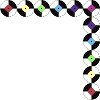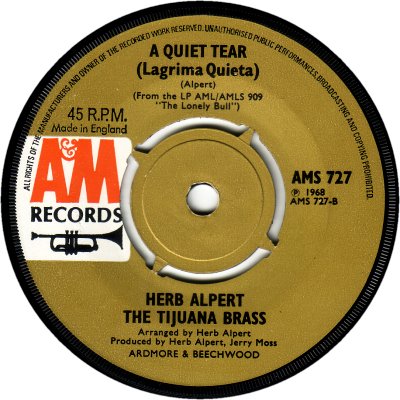
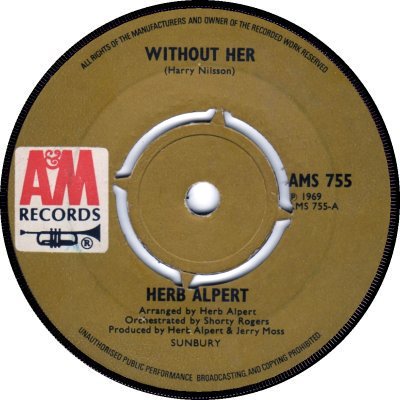
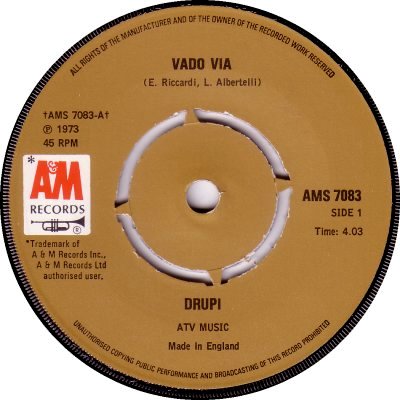
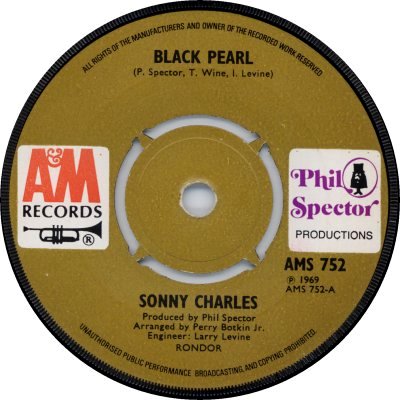
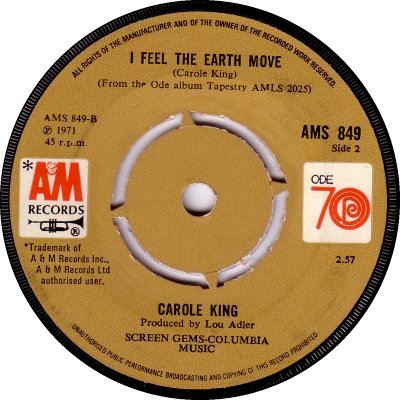
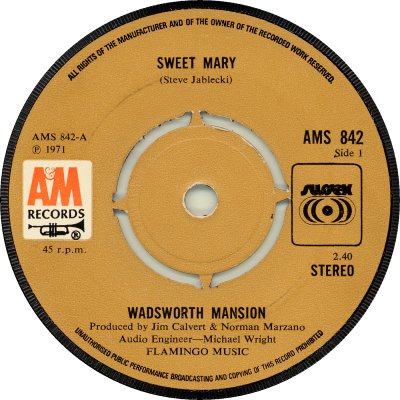
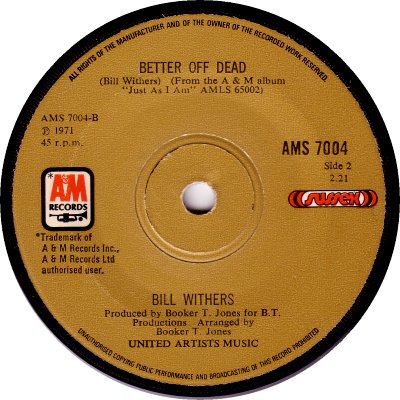
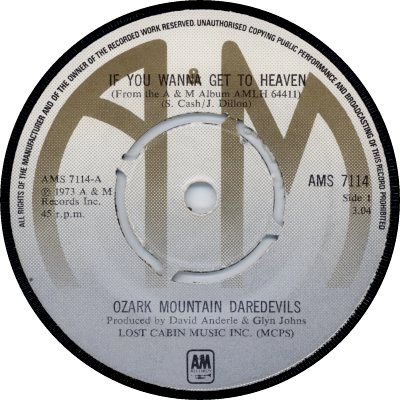

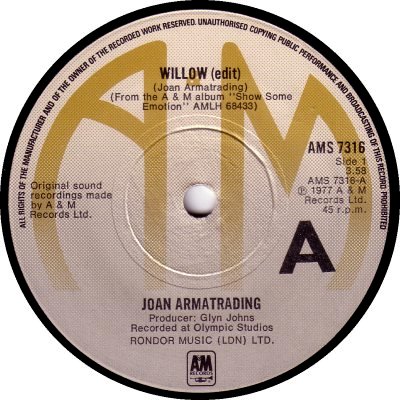
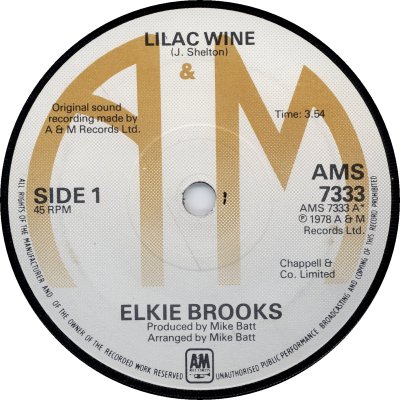

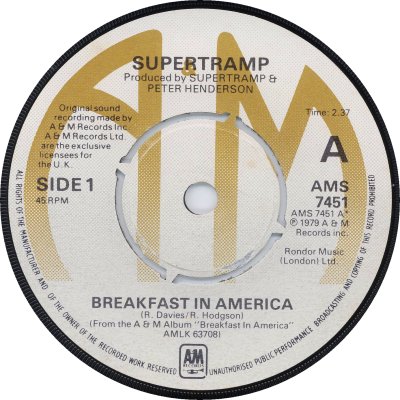

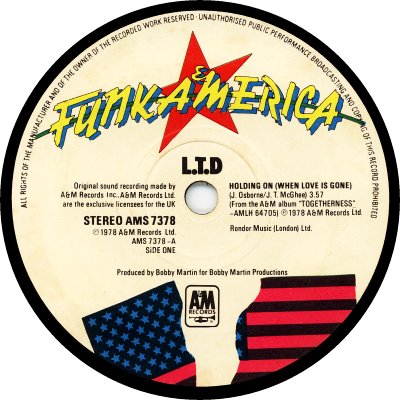
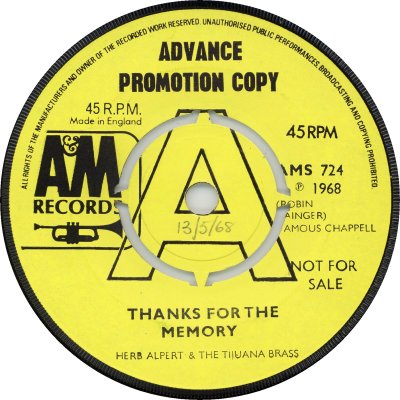
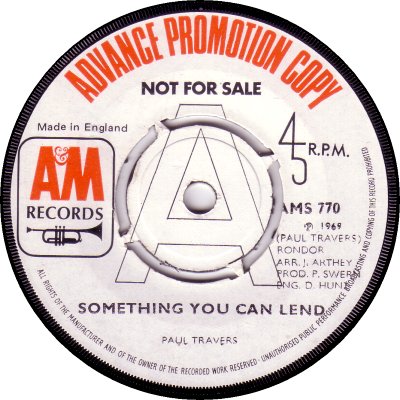
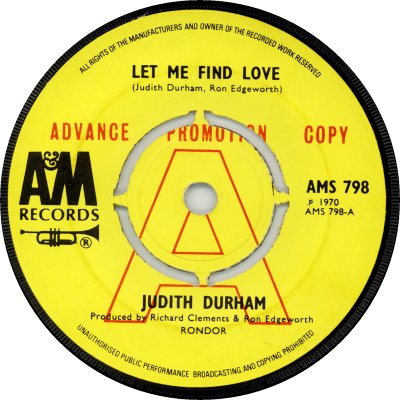
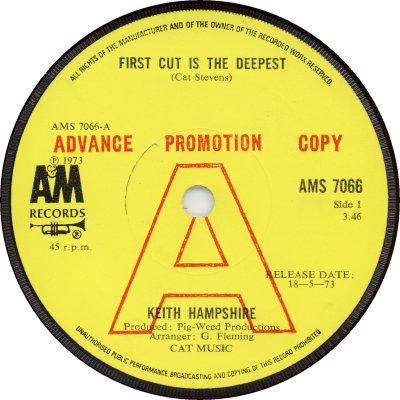
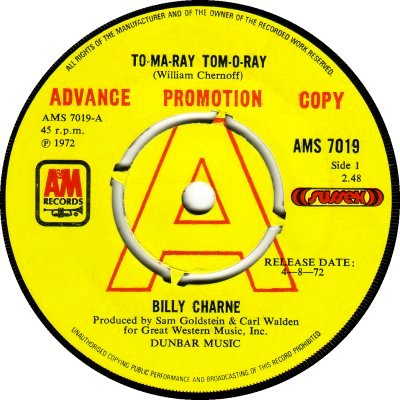

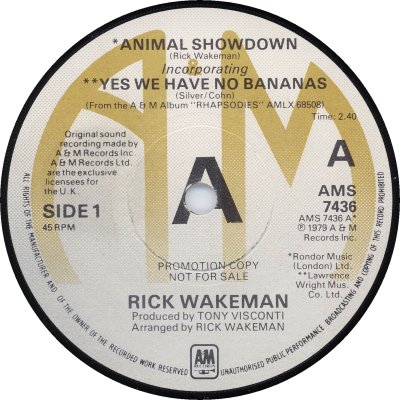
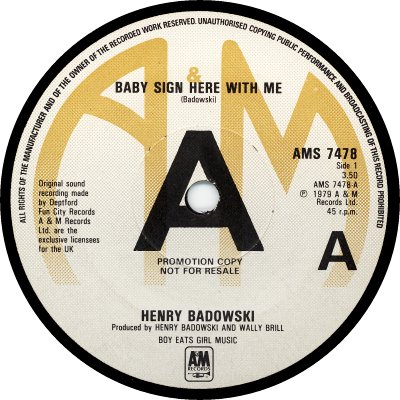
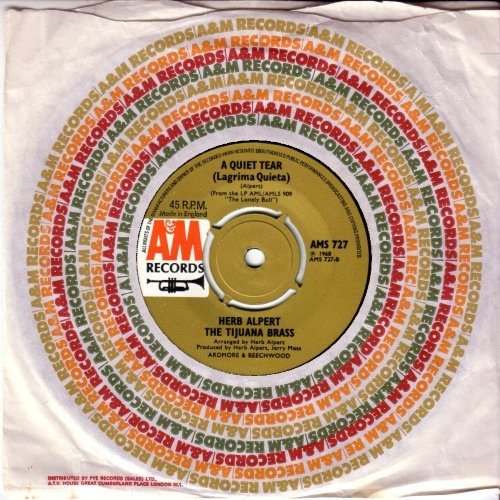
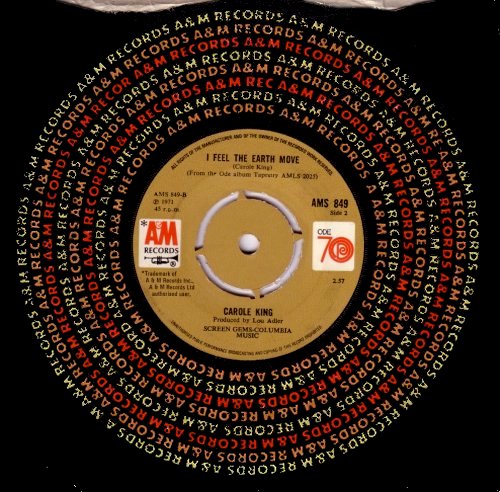
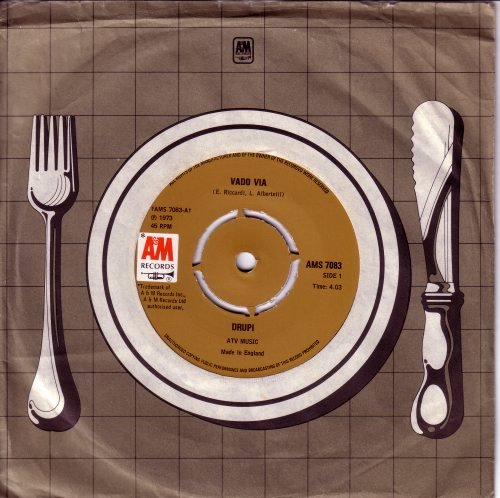
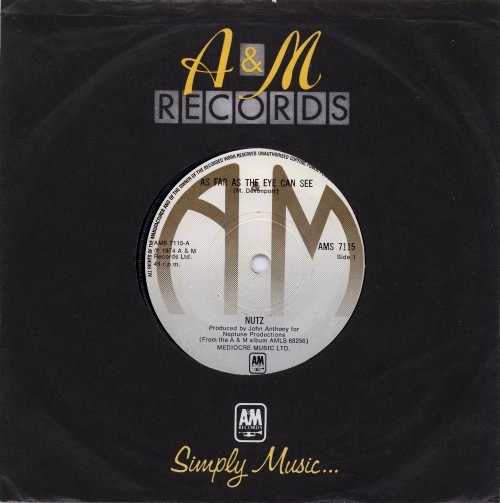
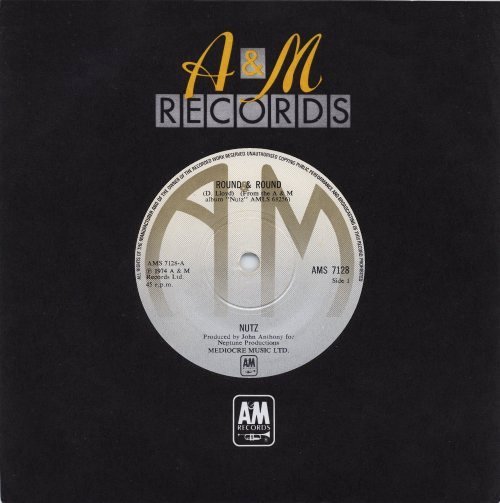
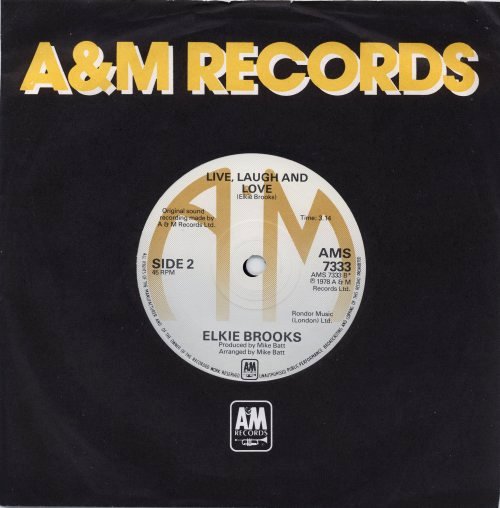
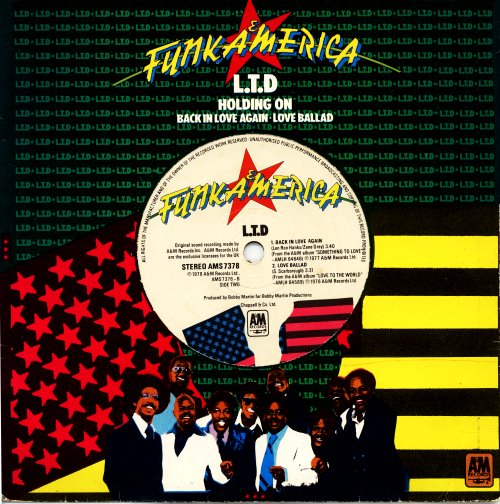
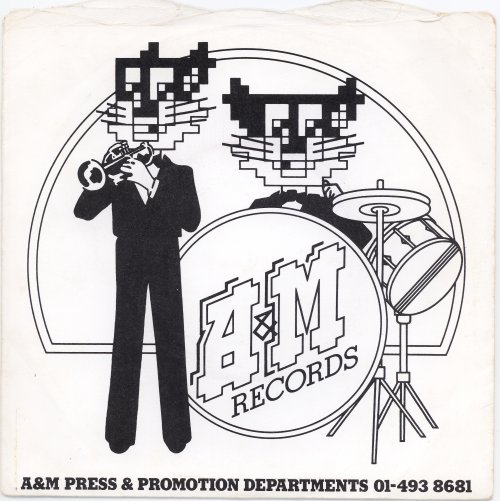
American. A&M was founded in 1962 by Herb Alpert and Jerry Moss in Los Angeles, but it relocated to Hollywood the following year. Initially an MOR-focused company, it diversified over the decades to cover a wide range of genres, and it went on to enjoy enormous success in the '70s and '80s with artists such as The Carpenters and The Police. As a result of all this, A&M came to be described as 'the most successful independent record company in history'. It 1989, however, it was bought by Polygram and lost its independence. It retained its own identity for a decade or so, initially under the guidance of Moss and Alpert, but lost its distictiveness and eventually became one more famous name in a sea of corporate sameness.
In the UK, A&M product was licensed to EMI at first, and it came out on the Stateside label. At the end of 1964 Pye took over the licensing and began issuing A&M's records on the Pye International label. A&M made its debut here as a label in its own right in the spring of 1967, again via a licensing deal with Pye; 'Record Retailer' of the 23rd of March said that the launch was due the following week. Numbering of the company's singles was in an AMS-700 series at first; it evolved into the AMS-880s and then, in March 1972, jumped from AMS-899 to AMS-7001. EPS started out in the AME-800s, but, presumably in order to avoid confusion, that series was replaced by an AME-600 one when the singles reached AMS-800. After the move to CBS it was changed to AMEP-1000.
The first single on the A&M label, 'Casino Royale' b/w 'The Wall Street Rag' by Herb Alpert & The Tijuana Brass (AMS-700; 3/67), got things off to a promising start, reaching the No.27 position in the Singles Chart. After the band's next four singles failed to repeat that success Alpert tried a solo 'A' side with 'This Guy's In Love With You' b/w 'A Quiet Tear' and took it into the Top 3. He managed a couple of minor hits from a steady stream of releases then suffered an eight-year absence from the Charts until 'Rise' b/w 'Aranjuez' (AMS-7465; 9/79) got to No.13. Elsewhere, hits initially proved hard to come by, with only The Sandpipers getting into the Top 40, which they did twice in 1968-69.
A&M had ambitions to strike out on its own, and it realized them in 1969. It began by putting some distance between itself and Pye: 'RR' of the 13th of February revealed that when the licensing agreement expired, in April, it was to be replaced by a 'long-term' one that only covered pressing and distribution. 'RR' of the 19th of March was able to say that the first single from the newly independent company would be AMS-747, 'Love Is All I Have To Give' b/w 'Never Should Have Lied' by The Checkmates, Ltd. The article added that A&M was looking to build up its roster of British artists. In pursuit of its independence the company opened a UK office, and it started searching for talent here - the search was to prove highly successful over the course of the next couple of decades. The change from licensed label to independent duly took place, but at first things didn't go according to plan. According to 'RR' of the 14th of February 1970 A&M had 'existed by courtesy of Island' until September 1969, presumably relying on Island for marketing and sales, but from September it got its act together and acted as an independent in its own right.
The occasional single kept A&M's name in the Chart, with The Checkmates Ltd. and Miguel Rios registering once apiece, but in the autumn of 1970 the company at last found a consistent hit-maker, in the shape of the Carpenters. Their debut single, 'They Long To Be Close To You' b/w 'I Kept On Loving You' (AMS-800; 9/70) stalled just outside the Top 5; it was followed by sixteen other Chart singles over the course of the next eight years. Two of them reached the No.2 spot: 'Yesterday Once More' b/w 'Road Ode' (AMS-7073; 6/73), and 'Please Mr. Postman' b/w 'This Masquerade' (AMS-7141; 11/74). Other artists to gain Chart placings - albeit lower ones - in 1971 or 1972 were Walter De Los Rios, Los Pop Tops, Billy Preston and Blue Haze; Carole King outdid them by taking 'It's Too Late' b/w 'I Feel The Earth Move' (AMS-849; 5/71) to No.6. Elsewhere, Strawbs repaid the company's faith in them when their seventh single, 'Lay Down' b/w 'Backside' (AMS-7039; 10/72) reached the No.12 position; the follow-up, 'Part Of The Union' b/w 'Will You Go' (AMS-7047; 1/73) equalled the Carpenters' highest placing, No.2, but their singles sales tailed off after that. Stealers Wheel and Hudson-Ford both provided a trio of hits in 1973-74, and Drupi's 'Vado Via' b/w 'Un Lette E Lei' (AMS-7083; 9/73) supplied a one-off Top 20 entry - it was one of the few foreign-language singles to crack the UK Charts.
'Music Week' of the 3rd of March 1973 referred to A&M 'intensifying its selling activities'; the intensification led to the company setting up its own sales force some twelve months later - 'MW' of the 12th of January 1974 reported that the development was due to take place the following March. The pressing and distribution deal with Pye had been renewed in August 1971, but 'MW' of the 9th of February announced that A&M would be leaving Pye and going to CBS on the 1st of April. 'MW' of the 16th of March confirmed that the move was on and that A&M would have its own sales team. The new partnership must have proved suitable: the deal - covering manufacture and distribution - was renewed in 1977 ('MW', 15th January) and saw the decade out. A&M remained independent after the switch.
The second half of the '70s saw A&M hitting its stride in terms of Singles Chart success. Andy Fairweather Low enjoyed a couple of Top 10 hits, while Captain & Tenille, Tubes, Rita Coolidge, Peter Frampton, Gallagher & Lyle, Supertramp, Joe Jackson and The Dickies all visited the Chart three times or more. Elkie Brooks made the Top 20 four times in 1977-78 and the Top 50 on a couple more occasions, but she was outdone by Squeeze, who took their distinctive sound into the Charts thirteen times from 1978 to 1982 and several more times after that period - 'Cool For Cats' b/w 'Model' (AMS-7426; 3/79) gave A&M another No.2. The company finally registered its first No.1 in 1979, courtesy of a band that quickly grew out of the Punk scene to become something of a phenomenon: The Police. 'Message In A Bottle' b/w 'Landlord' (AMS-7474; 9/79) was the record that did the trick; the trio repeated it with 'Walking On The Moon' b/w 'Visions Of The Night' (AMS-7494; 11/79), 'Don't Stand So Close To me' b/w 'Friends' (AMS-7564; 10/80) and 'Every Little Thing She Does Is Magic' b/w 'Flexible Strategies' (AMS-8174; 10/81). In addition to these they reached the No.2 position twice, and the No.5 and No.6 places once apiece. A&M had little to do with UK Punk bands, though they did notoriously sign the Sex Pistols ('MW' 19th March 1977) for a brief period, resulting in a cancelled single, 'God Save The Queen' b/w 'No Feeling' (AMS-7284; 3/77) - copies exist but currently (2021) change hands for four-figure sums.
A&M stuck with just a couple of label designs throughout the '60s and '70s, though both underwent minor changes. Pye-era labels were fawn in colour. Initially they had a perimeter 'prohibitions' text in one line at the top of the label (1). In the summer of 1969 the text split into two, with half going to the bottom; in addition the '45 RPM' and 'Made in England' that had been above the logo disappeared, and the logo itself shrank (2). The logo shrank again around July 1971; it gained an accompanying small '45 RPM' and the year, which were soon joined by a trademark statement (3). Records which were licensed to A&M carried the logo of the licensing company on the right hand side of the label (4, 5, 6); the A&M logo was sometimes reduced in size when accompanied by a licensing firm's logo (7).
The move to CBS was accompanied by a change of design to one in silver and dark brown, featuring a large 'A&M' (8). May 1975 saw a small black 'A' being incorporated into the layout of these labels, on the appropriate side (9); this 'A' varied in size and position. From around November 1975 to the end of 1976 the brown became lighter sporadically; this 'fawn' colour became standard from the start of 1977 (10). In March 1977 labels with a slightly different layout began to appear, in among the usual ones: they had the catalogue number on two lines instead of one, and instead of the 'A' they had the legend 'Side 1' or 'Side 2', at 9 o'clock. They also had the perimeter text at the bottom rather than the top (11). In May 1978 the 'A' was reintroduced to these 'split-level catalogue number' singles: much reduced in size it could be found above the catalogue number (12). There were some variations during May and June, with 'one-level catalogue number' singles having the 'Side 1' and the small 'A' above the number, but from July things settled down. Then in March 1979 the artists and titles swapped positions on the split-level singles, the artist name moving to the top (13); they remained in their old positions on the one-level labels - some fast-selling singles can be found with both types. With an occasional variant (22), the two types - 'Number on one line, larger 'A' at 4 o'clock, artist at bottom, text at top' and 'Number on two lines, smaller 'A' above it, 'Side 1' at 9 o'clock, artist at top, text at bottom' - ran in tandem for the rest of the decade. There doesn't seem to be any obvious logic as to which kind of layout was used for which single; some artists had records in both types. Occasionally popular singles were pressed by other companies at times of high demand: the Supertramp single shown above (13) was made by EMI - compare the narrow EMI-style dinking perforations with the broader CBS-style ones on the Ozark Mountain Daredevils and Dwight Twilley Band singles (8, 9). For some reason CBS were less prone to perforating their singles than the other companies were, and solid centres were the norm. Variations in vinyl colour, such as on the Squeeze single shown above (14) were generally accompanied by variations in the label colour; thanks to Simon Hughes for that scan. In addition there were individual label designs for several bands, such as The Dickies, The Tubes and Nine Below Zero. A 'FunkA&Merica' series of mainly 3-track EPs made its debut in 1978; it had its own label (15) and sleeve (30) designs and was sufficiently distinctive for me to give it its own page (q.v.).
Promos from the Pye era had yellow labels with black printing and large logos (16) until the winter of 1969; that design was replaced by a white label (17) which basically only lasted until March 1970, though it appeared on one or two later singles. For the rest of the Pye era promos had the usual Pye-family look: yellow, with the appropriate wording and a hollow 'A' in red. As was the case with the issues the logo shrank from medium-sized (18) to small (19) and sometimes dwindled still further when in combination with a licensing company's logo (20). From the autumn of 1972 until the move to CBS there was a special promo sleeve (31) which had information on the rear relevant to the particular single.
CBS-era promos initially had a small 'A' on the lower right-hand side, with a release date under it; they also had the words 'Not for sale' on them (21). From around May 1975 until around April 1978 there appear to have been no promo labels as such; presumably issue singles were sent out for promotional purposes. The black 'A' was retained for that period, but without the wording it merely indicated which was the 'A' side (9, 10, 12). After April 1978 promo markings reappeared, this time in the form of a central 'A' with the appropriate wording underneath it; the 'A' was usually solid, and it tended to vary in size. Promos with the catalogue number on two levels tended to keep the other, smaller, 'A' (21), while those with numbers in one line could either keep it (22) or lose it. As usual, the discography below only covers the 1970s. See also Firefly, Ode, Dark Horse, Kryptone, Shelter and A&M / Oval, all of which had A&M connections.


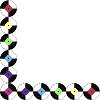
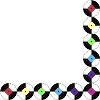
Copyright 2008 Robert Lyons.

